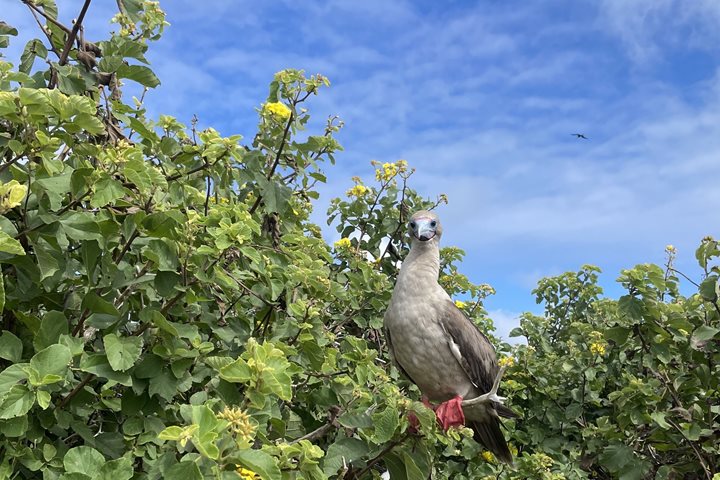After an overnight navigation we travelled from San Cristóbal to Española Island. Located in the southeast of the Galápagos Archipelago, this is one of the highlights of the week. The remnants of a very old shield volcano, now flattened and eroded on its southern coast, is the home to a variety of native and endemic seabirds mainly. This is due to the cold water currents that bathe Española, and it is perhaps for this reason that this isolated island has a high rate of endemism. In the morning we were anchored at Gardner Bay; with its white, coralline sands and shallow waters the landscape was dominated by blue and white. Snorkeling in the Galápagos Islands is a must, as there is so much to see: some preferred to practice at the beach while others took the deep water option by Gardner Islet. At the beach there was a number of sunbathing Galápagos sea lions; an endemic land bird, the Española mockingbird, kept us amused as it was constantly inspecting people’s backpacks and hats. In the latter part of the dry season, creatures on the island are desperate for water, which they have to get only from what they eat. The Pacific green sea turtles were particularly abundant in the shallow waters today, as both swimmers in the bay and kayakers could witness this morning.
After a delicious lunch, when we could have imagined things would be quiet, our Expedition Leader Paula announced that officers at the bridge had spotted a humpback whale and her calf. It was an unforgettable experience being able to observe the interaction between these amazing creatures from our ship and for quite a long time.
Eventually, our ship dropped anchor at Punta Suárez, just in time for our afternoon excursion. This is a point where a great amount of wildlife congregates, as due to the currents and winds there are plenty of nutrients. Just a few steps from our landing spot we were completely surrounded by amazing creatures like the endemic marine iguanas; they had finished grazing their algae so they were now basking in the sun to thermoregulate. Along the tiny beaches there was a number of Galápagos sea lion pups; just watching them play and play was a delight! We continued along the rocky trail to observe the marine birds Española is famous for. Here, there is a large colony of endemic Nazca boobies, and we were fortunate to observe them in every stage of their breeding cycle. A couple of Galapagos hawks landed not far from us; this is the apex predator of the terrestrial community of the islands. But the most majestic seabird of the islands was to be reached by the amazing cliffs of Punta Suarez: the waved albatross. Endemic to this island, this is the only tropical albatross in the world, and their only home is Española Island.
This was a colorful afternoon, full of incredible creatures and landscapes. Tomorrow, the island of Floreana awaits us... we simply cannot wait!









